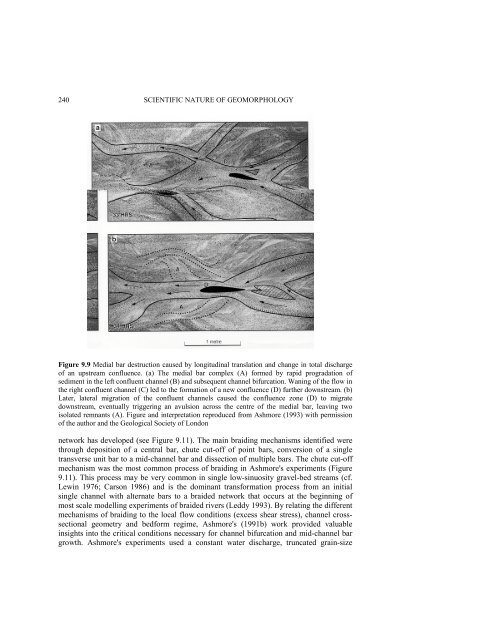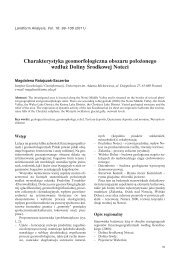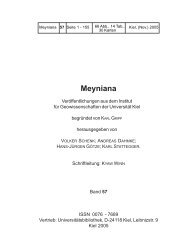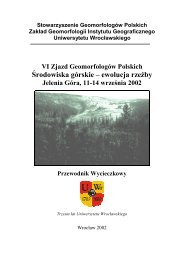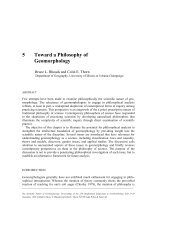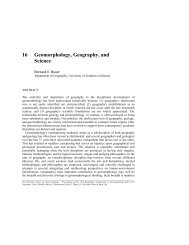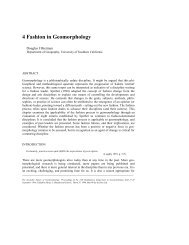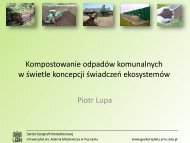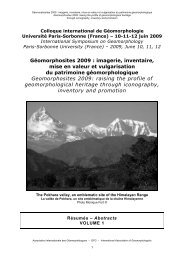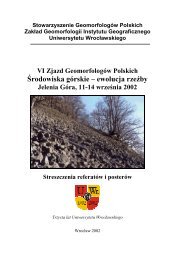Physical Modelling in Fluvial Geomorphology
Physical Modelling in Fluvial Geomorphology
Physical Modelling in Fluvial Geomorphology
Create successful ePaper yourself
Turn your PDF publications into a flip-book with our unique Google optimized e-Paper software.
240 SCIENTIFIC NATURE OF GEOMORPHOLOGY<br />
Figure 9.9 Medial bar destruction caused by longitud<strong>in</strong>al translation and change <strong>in</strong> total discharge<br />
of an upstream confluence. (a) The medial bar complex (A) formed by rapid progradation of<br />
sediment <strong>in</strong> the left confluent channel (B) and subsequent channel bifurcation. Wan<strong>in</strong>g of the flow <strong>in</strong><br />
the right confluent channel (C) led to the formation of a new confluence (D) further downstream. (b)<br />
Later, lateral migration of the confluent channels caused the confluence zone (D) to migrate<br />
downstream, eventually trigger<strong>in</strong>g an avulsion across the centre of the medial bar, leav<strong>in</strong>g two<br />
isolated remnants (A). Figure and <strong>in</strong>terpretation reproduced from Ashmore (1993) with permission<br />
of the author and the Geological Society of London<br />
network has developed (see Figure 9.11). The ma<strong>in</strong> braid<strong>in</strong>g mechanisms identified were<br />
through deposition of a central bar, chute cut-off of po<strong>in</strong>t bars, conversion of a s<strong>in</strong>gle<br />
transverse unit bar to a mid-channel bar and dissection of multiple bars. The chute cut-off<br />
mechanism was the most common process of braid<strong>in</strong>g <strong>in</strong> Ashmore's experiments (Figure<br />
9.11). This process may be very common <strong>in</strong> s<strong>in</strong>gle low-s<strong>in</strong>uosity gravel-bed streams (cf.<br />
Lew<strong>in</strong> 1976; Carson 1986) and is the dom<strong>in</strong>ant transformation process from an <strong>in</strong>itial<br />
s<strong>in</strong>gle channel with alternate bars to a braided network that occurs at the beg<strong>in</strong>n<strong>in</strong>g of<br />
most scale modell<strong>in</strong>g experiments of braided rivers (Leddy 1993). By relat<strong>in</strong>g the different<br />
mechanisms of braid<strong>in</strong>g to the local flow conditions (excess shear stress), channel crosssectional<br />
geometry and bedform regime, Ashmore's (1991b) work provided valuable<br />
<strong>in</strong>sights <strong>in</strong>to the critical conditions necessary for channel bifurcation and mid-channel bar<br />
growth. Ashmore's experiments used a constant water discharge, truncated gra<strong>in</strong>-size


